How to enhance your lifestyle and well-being with electric bikes
- Blog How to enhance your lifestyle and well-being with electric bikes
This summer, due to various circumstances, we decided to become a one-car family, temporarily, from early summer until fall. We live in Portland so it's an easy transition. Luckily, the roads have special bike lanes and whole streets are dedicated to only bikes. While I know this isn’t the case everywhere, we see this trend growing – especially electric bikes. Many cities are embracing biking as a form of transportation – even with kids.
While I love biking, I have to admit that since Mason was born, I’ve grown quite lazy about it. I haven’t biked much with his 40 pounds on the back, even though I have a great bike and bike seat for him. I like a workout, but going uphill with a kid on the back pretty much sucks, in my opinion. Luckily my husband does most of the kid hauling when we head out to bike as a family, so this hasn’t been a problem. This summer when we had an opportunity to try out a Rad Power Bike, I jumped at the chance. My gut told me it would give us a chance at trying out being a one-car family for a few weeks.
Electric bikes have been gaining in popularity over the last few years. At first the higher price tag made them more of a specialty item; however, with improved technology and more competition on the market, electric bikes are popping up everywhere.
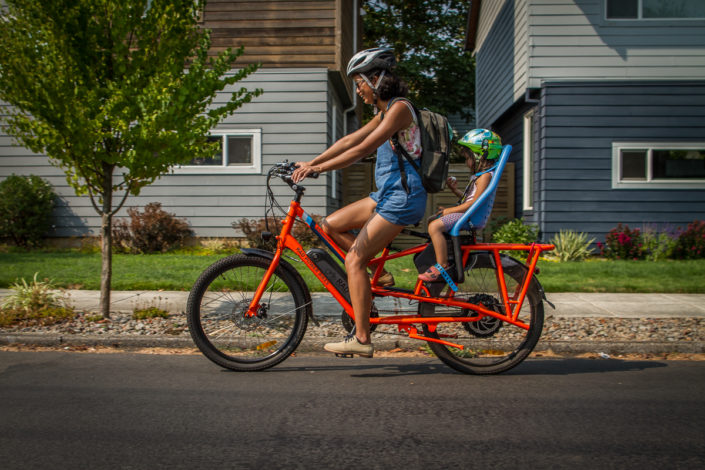
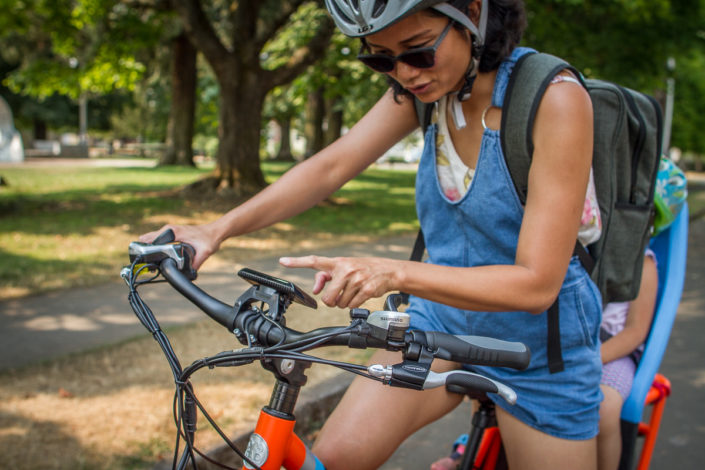 You also need to baby it a little bit. Don't leave it out in a heavy rainstorm because there is a lot of technology on it that could fizzle with hard weather. While we didn’t test it much in rain because it was summer, we did ride in a slight misting and it seemed fine. I imagine that since it’s a bike and meant to be outside, after all, light weather is certainly okay.
You also need to baby it a little bit. Don't leave it out in a heavy rainstorm because there is a lot of technology on it that could fizzle with hard weather. While we didn’t test it much in rain because it was summer, we did ride in a slight misting and it seemed fine. I imagine that since it’s a bike and meant to be outside, after all, light weather is certainly okay.
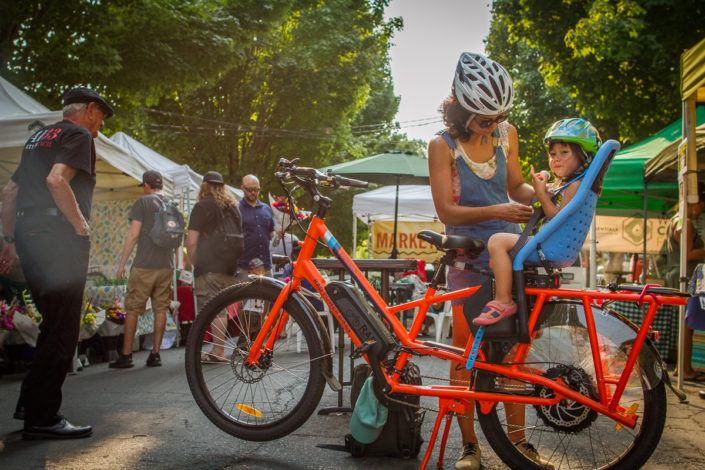 Here are a few more things to think about with biking versus driving: More time spent outside for you and your child, a better sense of balance from time spent on a bike, an increased awareness of your neighborhood since you're traveling at slower speed, and you experience more sights, sounds and smells around you.
The pluses for your health can’t be disputed. According to a study conducted by James Blumenthal of Duke University, when you start exercising, whether running, walking or pedaling, your brain gets a boost in serotonin. In a lab rat study he conducted in 2015, serotonin increased by 200 percent as soon as lab rats started running on a wheel. Also, the heightened serotonin lasts all day, which boosts moods and strengthens brain power.
A mere 30 minutes on a bike can also grow your brain. Apparently, the increased oxygen due to enlarging capillaries and the increase in brain-building protein can double and even triple cell production in the brain. Cycling is linked to a decrease in heart disease and cancer.
Here are a few more things to think about with biking versus driving: More time spent outside for you and your child, a better sense of balance from time spent on a bike, an increased awareness of your neighborhood since you're traveling at slower speed, and you experience more sights, sounds and smells around you.
The pluses for your health can’t be disputed. According to a study conducted by James Blumenthal of Duke University, when you start exercising, whether running, walking or pedaling, your brain gets a boost in serotonin. In a lab rat study he conducted in 2015, serotonin increased by 200 percent as soon as lab rats started running on a wheel. Also, the heightened serotonin lasts all day, which boosts moods and strengthens brain power.
A mere 30 minutes on a bike can also grow your brain. Apparently, the increased oxygen due to enlarging capillaries and the increase in brain-building protein can double and even triple cell production in the brain. Cycling is linked to a decrease in heart disease and cancer.
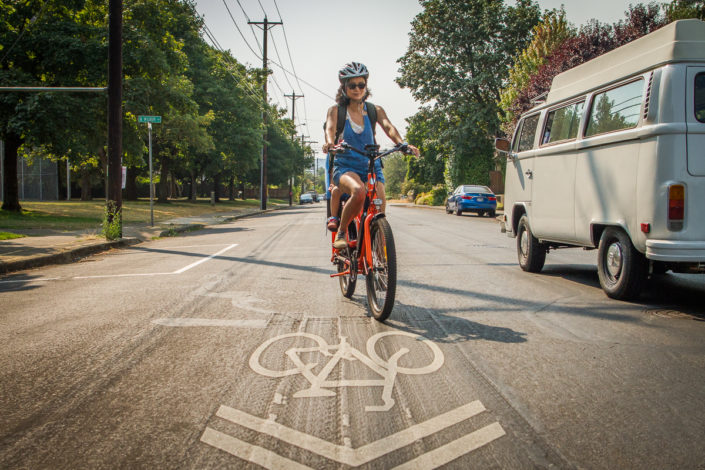 If you live in Portland or some of the other bike cities around the U.S., having one car and making a bike your second form of transportation is a growing trend. If you look around the world, traveling around cities with a bike piled high with kids and your daily shopping goods is pretty normal. In the U.S., this is a new phenomenon, though that’s changing daily. With electric bikes, it’s easy to see how this might convince those who are wary of biking with kids to give pedaling a try.
If you've made the transition to electric bikes, please share your tips with us in the comments below.
If you live in Portland or some of the other bike cities around the U.S., having one car and making a bike your second form of transportation is a growing trend. If you look around the world, traveling around cities with a bike piled high with kids and your daily shopping goods is pretty normal. In the U.S., this is a new phenomenon, though that’s changing daily. With electric bikes, it’s easy to see how this might convince those who are wary of biking with kids to give pedaling a try.
If you've made the transition to electric bikes, please share your tips with us in the comments below.
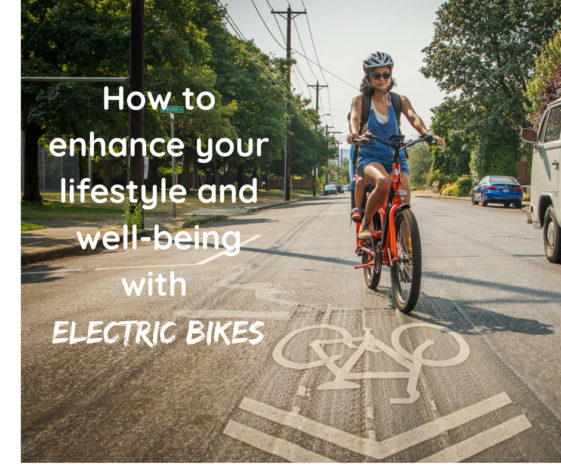 *This is a sponsored post brought to you by Rad Power Bikes. The opinions are completely based on our own experience with the product. As a nonprofit organization, Hike it Baby chooses to partner with companies that believe in getting families outside and review their products for our community. We received product and compensation to review this bike and share our experience.
*This is a sponsored post brought to you by Rad Power Bikes. The opinions are completely based on our own experience with the product. As a nonprofit organization, Hike it Baby chooses to partner with companies that believe in getting families outside and review their products for our community. We received product and compensation to review this bike and share our experience.

Getting past the hurdles of electric bikes
I’ll admit I was a little wary of the electric bike when it showed up at our house. First of all, it was very heavy, weighing in at about 75 pounds. This can be a little intimidating when you don’t bike a lot. I notice this reaction from others when I first roll up. I often offer it to others for a ride, but I can see the nervous reaction in the “no, that’s ok” look they give me. This comes from the fact that it doesn’t just look heavy – you can feel the weight before you even push it off the kickstand. Everything about electric bikes feels more intense. For intense, the kickstand is a solid scooter or motorcycle-like kickstand with two legs on it. An important thing to know about electric bikes: they need power, so you have to pay attention to where your battery is at and when it needs a charge. With such a heavy bike, you can choose to pedal it on flat ground, but forget about going uphill without the electric assist. Charging is easy; however, you have to remember to plug it in after every ride so you don’t suddenly find yourself on a ride without power. Also, there are a lot of cables, buttons and a control center panel on the handlebars. If you are not mechanically inclined, it could create a barrier for getting on an electric bike. You also need to baby it a little bit. Don't leave it out in a heavy rainstorm because there is a lot of technology on it that could fizzle with hard weather. While we didn’t test it much in rain because it was summer, we did ride in a slight misting and it seemed fine. I imagine that since it’s a bike and meant to be outside, after all, light weather is certainly okay.
You also need to baby it a little bit. Don't leave it out in a heavy rainstorm because there is a lot of technology on it that could fizzle with hard weather. While we didn’t test it much in rain because it was summer, we did ride in a slight misting and it seemed fine. I imagine that since it’s a bike and meant to be outside, after all, light weather is certainly okay.
Finding more opportunities for more adventures
What I loved about this bike from the moment I got on it is that it felt like it opened up a whole new world for me with biking. Suddenly, I found I was excited to run errands on the bike. I was fine with taking the time to get Mason “bike-ready”. Loading gear up to head out was now exciting in a way it had never been with my bike and trailer. The electric bike makes going longer distances no big deal, especially if there are only mild hills involved. I also saw Mark heading for further adventures on the bike. One afternoon when my sister headed to a newly opened park on the southwest side of town with her kids, about 20 miles roundtrip, Mark loaded Mason up and off they went. We figured worst case scenario if they didn’t make it, they could load the bike onto the front of a bus or my sister could, maybe, get it into her mini van and drive them home. A few hours later they sent pictures from the playground. And when they got back, we saw that Mark made it across town and back with juice to spare in the battery. At the park, two other dads rode up with kids on cargo bikes and Mark said his bike proved to be a conversation piece. This brought my normally fairly introverted husband out of his shell to chat with the dads about bike adventures with kids. Another plus of having an electric bike is that people are really curious and will ask you a lot of questions.Gaining health and lifestyle benefits
In a time when gas is getting increasingly expensive, as are cars; electric bikes are a great alternative for families. The minimal repairs you can expect with an electric bike are flat tires, which are a cheap and an easy fix once you learn how, and when the battery goes out after a few years. You can expect a battery to last three years on most electric bikes (depending on use) and will cost about $500 to replace it. Here’s a list of general fixes on a bike:- Tune-up: $75 – $100+
- Flat tire (not including tube cost): $10 – $20
- Brake adjustments: $20 – $35
- Drivetrain replacement or adjusting: $20 – $60
 Here are a few more things to think about with biking versus driving: More time spent outside for you and your child, a better sense of balance from time spent on a bike, an increased awareness of your neighborhood since you're traveling at slower speed, and you experience more sights, sounds and smells around you.
The pluses for your health can’t be disputed. According to a study conducted by James Blumenthal of Duke University, when you start exercising, whether running, walking or pedaling, your brain gets a boost in serotonin. In a lab rat study he conducted in 2015, serotonin increased by 200 percent as soon as lab rats started running on a wheel. Also, the heightened serotonin lasts all day, which boosts moods and strengthens brain power.
A mere 30 minutes on a bike can also grow your brain. Apparently, the increased oxygen due to enlarging capillaries and the increase in brain-building protein can double and even triple cell production in the brain. Cycling is linked to a decrease in heart disease and cancer.
Here are a few more things to think about with biking versus driving: More time spent outside for you and your child, a better sense of balance from time spent on a bike, an increased awareness of your neighborhood since you're traveling at slower speed, and you experience more sights, sounds and smells around you.
The pluses for your health can’t be disputed. According to a study conducted by James Blumenthal of Duke University, when you start exercising, whether running, walking or pedaling, your brain gets a boost in serotonin. In a lab rat study he conducted in 2015, serotonin increased by 200 percent as soon as lab rats started running on a wheel. Also, the heightened serotonin lasts all day, which boosts moods and strengthens brain power.
A mere 30 minutes on a bike can also grow your brain. Apparently, the increased oxygen due to enlarging capillaries and the increase in brain-building protein can double and even triple cell production in the brain. Cycling is linked to a decrease in heart disease and cancer.
 If you live in Portland or some of the other bike cities around the U.S., having one car and making a bike your second form of transportation is a growing trend. If you look around the world, traveling around cities with a bike piled high with kids and your daily shopping goods is pretty normal. In the U.S., this is a new phenomenon, though that’s changing daily. With electric bikes, it’s easy to see how this might convince those who are wary of biking with kids to give pedaling a try.
If you've made the transition to electric bikes, please share your tips with us in the comments below.
If you live in Portland or some of the other bike cities around the U.S., having one car and making a bike your second form of transportation is a growing trend. If you look around the world, traveling around cities with a bike piled high with kids and your daily shopping goods is pretty normal. In the U.S., this is a new phenomenon, though that’s changing daily. With electric bikes, it’s easy to see how this might convince those who are wary of biking with kids to give pedaling a try.
If you've made the transition to electric bikes, please share your tips with us in the comments below.
Read more
- Best bike trailers for kids - Gear review
- Rolling into spring: Stroller review
- Backpacking with the family: Four-man tent review
Photos by Andrea Leoncavallo
 *This is a sponsored post brought to you by Rad Power Bikes. The opinions are completely based on our own experience with the product. As a nonprofit organization, Hike it Baby chooses to partner with companies that believe in getting families outside and review their products for our community. We received product and compensation to review this bike and share our experience.
*This is a sponsored post brought to you by Rad Power Bikes. The opinions are completely based on our own experience with the product. As a nonprofit organization, Hike it Baby chooses to partner with companies that believe in getting families outside and review their products for our community. We received product and compensation to review this bike and share our experience.
Related Content




Comments